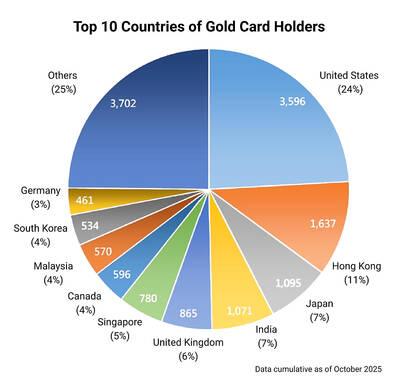Sitting lotus-style on an apartment floor, two women quietly rotate their arms in front of them — a rare sight in China where public displays of Falun Gong meditation have all but disappeared.
It is a shadow of the spiritual movement’s heyday in China, where the group once boasted more than 70 million followers before it was outlawed in 1999, giving police carte blanche to persecute members.
But 20 years on, the group has remained stubbornly persistent, even as practitioners in mainland China continue to face arrests and torture, according to rights groups.

Photo: AFP
Before the crackdown, Falun Gong members would congregate in parks in large numbers to practice qigong meditation. Now they do their slow movement exercises behind closed doors.
“It doesn’t matter how the Communist Party suppresses [Falun Gong], I don’t think about it too much,” one of the women, who requested anonymity due to the sensitivity of the topic, said.
“I just do what I want to do,” she added.
Falun Gong, which emphasizes moral teachings, was once encouraged by Chinese authorities to ease the burden on a creaky health system after it was unveiled in 1992 by Li Hongzhi (李洪志), who emigrated to the US four years later.
But after over 10,000 Falun Gong members surrounded Communist Party headquarters in central Beijing on April 25, 1999, to protest the detention of some of their members, the government leapt into action.
Then-president Jiang Zemin (江澤民) issued orders to eliminate the group, which was later declared an “evil cult” — a tactic to justify the repression, scholars say.
Top officials “see Falun Gong, first and foremost, as an ideological and political threat”, Maria Cheung, a University of Manitoba professor who has researched the movement, said.
The demonstration had been the biggest protest in Beijing since the Tiananmen Square pro-democracy sit-in in 1989.
‘FLESH AND BLOOD’
Following the protest, Chinese authorities launched a special security bureau known as the “610 office” to suppress and monitor Falun Gong followers.
Practitioners and rights groups have also reported death, torture, and abuse at labor camps.
One woman from northern China recounted a traumatic period when her father was pressured by local authorities to beat his younger sister, who was a “very resolute practitioner of Falun Gong.”
He was “forced to break his own flesh and blood, resulting in my aunt hating her own brother for many years,” she said, shuddering with tears.
David Ownby, a history professor at the University of Montreal who has studied Falun Gong, said cults emerge in China because the officially atheist state has successfully kept traditional religions weak.
“That means that part of the market is open to groups that are not sanctioned,” he said. “That is the basic paradox at the heart of the religion policy.”
A Falun Gong follower in China, who joined in 2010, said that her dissatisfaction with society and family life turned her towards the spiritual movement.
“I thought that maybe a bit of (religious) faith would make me better,” she said, adding that she had also been exposed to Buddhism.
While Falun Gong survives underground in mainland China, it has swelled among the Chinese diaspora, as followers have fled overseas in search of asylum.
Falun Gong is practiced in over 70 countries, according to Falun Dafa Info Center, the group’s press office.
The movement has also turned “hard-edged” over the years, said Ownby, with some academics reporting harassment for calling Falun Gong a sect or cult.
Levi Browde, the center’s executive director, said he believes if harassment has occurred, it is simply an effort by Falun Gong practitioners “to provide more information to the scholars.”
MORE POLITICAL STANCE
It is about “making sure we’re not adding momentum to the wave of violence and death that engulfs the lives of Falun Gong practitioners throughout China”, he said.
The spiritual movement has also adopted a more political stance in some parts of the world.
In Hong Kong, where Falun Gong activists hand out fliers and try to talk to people — especially mainland tourists — the movement has taken on a stridently anti-communist tone.
One key slogan, seen on banners and blared through loudspeakers is: “The heavens will destroy the Chinese Communist Party.”
Zhang Yucheng, a 76-year-old Falun Gong member who distributes the anti-communism newspaper The Epoch Times to passers-by in Hong Kong, said he did not join the spiritual movement to be a dissident.
“I was a Chinese Communist Party member,” he said. But when the party decided to “fight against Falun Gong and started to tell lies,” he felt he was left with no choice.
“If one continues to tell the truth, they will end up like me, expelled from the party,” Zhang added.
Beijing’s efforts to eliminate Falun Gong and other groups it deems heretical show no sign of abating, with dedicated “cult prevention and handling” departments active around the country.
More than 900 Falun Gong followers were sentenced to prison between January 2013 and June 2016, according to a 2017 report by Freedom House.
This year, posters appeared on public walls in Beijing warning people against cults, with the message: “wipe your eyes and stay awake.”
The government is “calm on the surface but controlling underneath” said the Falun Gong follower from northern China.
“I don’t think they have loosened up.”
“Whether it’s wire-tapping or contacting you time and again,” she said, “they still want to control.”

Seven hundred job applications. One interview. Marco Mascaro arrived in Taiwan last year with a PhD in engineering physics and years of experience at a European research center. He thought his Gold Card would guarantee him a foothold in Taiwan’s job market. “It’s marketed as if Taiwan really needs you,” the 33-year-old Italian says. “The reality is that companies here don’t really need us.” The Employment Gold Card was designed to fix Taiwan’s labor shortage by offering foreign professionals a combined resident visa and open work permit valid for three years. But for many, like Mascaro, the welcome mat ends at the door. A

Last week gave us the droll little comedy of People’s Republic of China’s (PRC) consul general in Osaka posting a threat on X in response to Japanese Prime Minister Sanae Takaichi saying to the Diet that a Chinese attack on Taiwan may be an “existential threat” to Japan. That would allow Japanese Self Defence Forces to respond militarily. The PRC representative then said that if a “filthy neck sticks itself in uninvited, we will cut it off without a moment’s hesitation. Are you prepared for that?” This was widely, and probably deliberately, construed as a threat to behead Takaichi, though it

Nov. 17 to Nov. 23 When Kanori Ino surveyed Taipei’s Indigenous settlements in 1896, he found a culture that was fading. Although there was still a “clear line of distinction” between the Ketagalan people and the neighboring Han settlers that had been arriving over the previous 200 years, the former had largely adopted the customs and language of the latter. “Fortunately, some elders still remember their past customs and language. But if we do not hurry and record them now, future researchers will have nothing left but to weep amid the ruins of Indigenous settlements,” he wrote in the Journal of

If China attacks, will Taiwanese be willing to fight? Analysts of certain types obsess over questions like this, especially military analysts and those with an ax to grind as to whether Taiwan is worth defending, or should be cut loose to appease Beijing. Fellow columnist Michael Turton in “Notes from Central Taiwan: Willing to fight for the homeland” (Nov. 6, page 12) provides a superb analysis of this topic, how it is used and manipulated to political ends and what the underlying data shows. The problem is that most analysis is centered around polling data, which as Turton observes, “many of these